Edd Gibson: Leading through teaching and planning
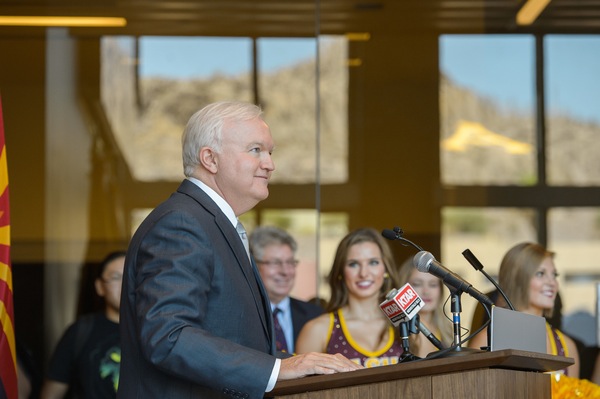
“Planning is the intersection between business and engineering,” Gibson said. “Why are we doing the project? How should we proceed? What is the scope? It’s all about people and risk management, and this is when you have the largest influence on creating a successful project.”
G. Edward “Edd” Gibson Jr., professor and former director of the School of Sustainable Engineering and the Built Environment, one of the Ira A. Fulton Schools of Engineering at Arizona State University, loves teaching, both in a university setting and for the construction industry.
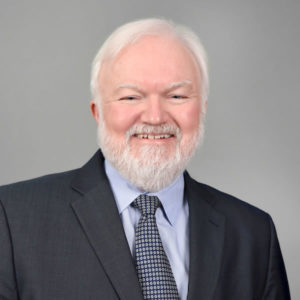
Edd Gibson
“There’s an adrenaline rush standing before a group of people and interacting with them,” Gibson said. “I grew up in a town of 3,500 people, and I’ve given presentations in front of a group that size.”
He has received numerous national awards, including the most recent this year as CII Outstanding Instructor from the national Construction Industry Institute.
Gibson’s research and teaching on construction planning have taken him from university classrooms to construction projects around the world, helping governments and private industries that believe his methods have saved billions of dollars.
“Planning is the intersection between business and engineering,” Gibson said. “Why are we doing the project? How should we proceed? What is the scope? It is all about people and risk management, and this is when you have the largest influence on creating a successful project.
“I have an approach that’s effective. I’ve developed it over 25 years.”
Despite larger and more efficient computer programs, Gibson said that, in his opinion, planning for construction projects is in worse shape than when he started.
“It is still meat and potatoes,” Gibson said. “There’s the ability to transfer information differently, but there are fewer people now with the experience and expertise to plan. Companies haven’t maintained their intelligence supply. Some companies are really good at it, but others are struggling.”
Gibson first learned about construction from his father, a forester for the Woodlands Division of the American Can Company, which managed woodlands for lumber for paper products such as Northern Tissue.
“I would ride with my father all over southwest Alabama, looking at logging operations,” Gibson said. “I saw truss bridges, and watched tugboats go under them.
“When I was 8, he took me to see a lock and dam near Jackson, Alabama. I watched a tugboat go through and I said, ‘That’s what I want to do—design and build that.’ ”
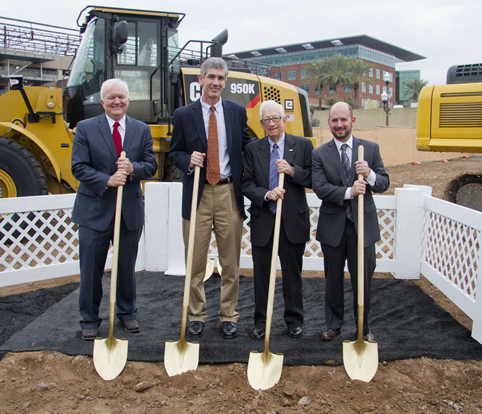
Edd Gibson breaking ground for the College Avenue Commons.
Gibson learned about civil engineering, and was convinced.
“I said, ‘I want to build a bridge that’s a dam and a water treatment facility, all together,’ ” Gibson said, laughing. “It doesn’t work.”
Growing up in the woods gave Gibson a sense of freedom most children no longer have.
“I would go out in the woods in the morning and come home when it got dark,” he said. “I’d go fishing in the creek behind our house. I dammed it up to build a reservoir.”
In high school, he took the hardest classes and won his school’s math/science/language award, even though he didn’t take a foreign language class.
With a full scholarship from the Army ROTC, Gibson headed to Auburn University, where he earned a bachelor of science degree in civil engineering in 1980, and was commissioned as a second lieutenant.
He spent his summers in college building roads and bridges for the American Can Company, operating bulldozers, managing crane crews and driving bucket loaders and dump trucks.
After graduating, he served four years active duty andseven years in the reserves, leaving as a captain, and working in Fort Benning in Georgia, Fort Lewis in Washington, and Fort Belvoir in Virginia. He built assault airstrips in Honduras, almost went to Grenada, and managed projects for the U.S. Air Force in south Georgia. Along the way, he met and married his wife, Gail.
After leaving active service, Gibson moved to Dallas, where he worked on his MBA at night at the University of Dallas, and for Texas Instruments during the day, contributing to the physics and testing for target acquisition and optics for the Strategic Defense Initiative.
“I wasn’t working in the area I was educated in, and I decided I didn’t want to be in national defense for the rest of my career,” Gibson said. “I thought it would be neat to be a teacher, but to work at a university, you needed a doctorate.”
So Gibson headed back to Auburn University, where he earned his doctorate in civil engineering in 1990.
“I got my feet wet teaching as a grad student at Auburn, teaching seven or eight classes in computer methods and contracts,” Gibson said.
But when he graduated, tenure-track positions were hard to find. He was a visiting professor at North Carolina State University, then was hired by The University of Texas at Austin, where he taught civil engineering for 15 years.
It was at Austin that Gibson began to develop his research in planning and risk management, and sharing his knowledge through outreach to industry.
“I learned I was good on the podium, in front of industry,” Gibson said. “I could relate to them because of my industry experience. I found out it wasn’t easy for everyone. It is a different kind of teaching.”
As a consultant, Gibson has worked for the U.S. Department of Energy, the U.S. Department of Health and Human Services, the U.S. Army Corps of Engineers, the National Institutes of Health, NASA, the General Services Administration and the Centers for Disease Control and Prevention. He has advised Amgen, Access Midstream, ExxonMobil, Phillips, 3M Company, Williams, and Anheuser-Busch, among others.
He’s taught in South Africa, Australia, Europe and Korea.
He’s helped with projects including the MD Anderson Cancer Center in Houston, the Smithsonian National Air and Space Museum’s Steven F. Udvar-Hazy Center near Washington Dulles International Airport in Virginia, the renovation of the National Museum of American History and the National Portrait Gallery.
He has worked on the risk analysis of U.S. interests in the ITER project, the largest nuclear fusion project in the world, located in southern France.
He gave a seminar for Global Infrastructure Partners, the company that owns both Gatwick and Edinburgh airports.
Eventually, Gibson was hired by The University of Alabama to start its construction engineering program and get it accredited. He spent three years there.
Five years ago, he came to ASU to lead the nationally recognized Del E. Webb School of Construction.
“It is a different, bigger job, but what I learned at Texas and Alabama, made it easier,” he said.
Gibson can discuss the traits of a good teacher like someone who has studied the issue. And, actually, that is one of the traits.
“I had several teachers in high school and college who were outstanding, and so I took as many classes as possible from them,” Gibson said. “They were hard but fair. They were organized and taught things that were applicable to my future career and life. They weren’t jerks. You don’t want to be the person that people don’t want to be around.”
Gibson said a good teacher must have mastery of the subject matter, being able to build on it, synthesize and use it and relate it to the student. They must have enthusiasm about helping people, be tough but fair, and assert their authority.
“You can’t be friends with your students,” Gibson said. “It breaks down the teacher/ student relationship. You can develop long-term relationships later, but while they are students, there has to be some separation.”
Gibson said students have come back years later to tell him that his guidance changed their lives.
“They’ll say, ‘I had you in 1993. I came to office hours to ask you about what work I should do, and you gave me the best advice I ever got.’ Sometimes I remember, sometimes I don’t, but I said the right thing at the right time,” he said, smiling.
Gibson said he moved into administrative work to have a larger impact.
“As a faculty member, I can affect 40 young people in the classroom,” Gibson said. “As director, I affect 1,350 students, even though they might not know my name. I work with faculty, resources, guidance and strategic direction.”
He sends most of his new faculty members to the ExCEED: Excellence in Civil Engineering Education program at the U.S. Military Academy at West Point, where they learn about lesson plans and how to prepare a syllabus, as well as being filmed while teaching so they can analyze their style.
Gibson hasn’t given up teaching entirely. This fall he’s teaching two ASU 101 classes and a graduate course on planning, which has 36 students. And he still does research.
He jokingly calls teaching a hobby, saying he’s so busy during the week that he does his planning and grading on Sundays and his research in the evenings.
Gibson will get to test his teaching theories this fall when his son, Gaines, who finished his bachelor’s degree at ASU last spring, will take Gibson’s graduate planning class.
“I’ve already told him that I will be grading his work first, and it will receive the harshest grade,” Gibson said. “My daughter, Stacey, who got her degree in civil engineering at Texas A&M University, said she would never take a class from me.”
Never say never, Gibson said, smiling. Stacey is enrolled in one of his industry outreach short courses this fall.
These faculty profiles were written as part of the celebration of the grand opening of the College Avenue Commons, the home of the Del E. Webb School of Construction, in 2014.
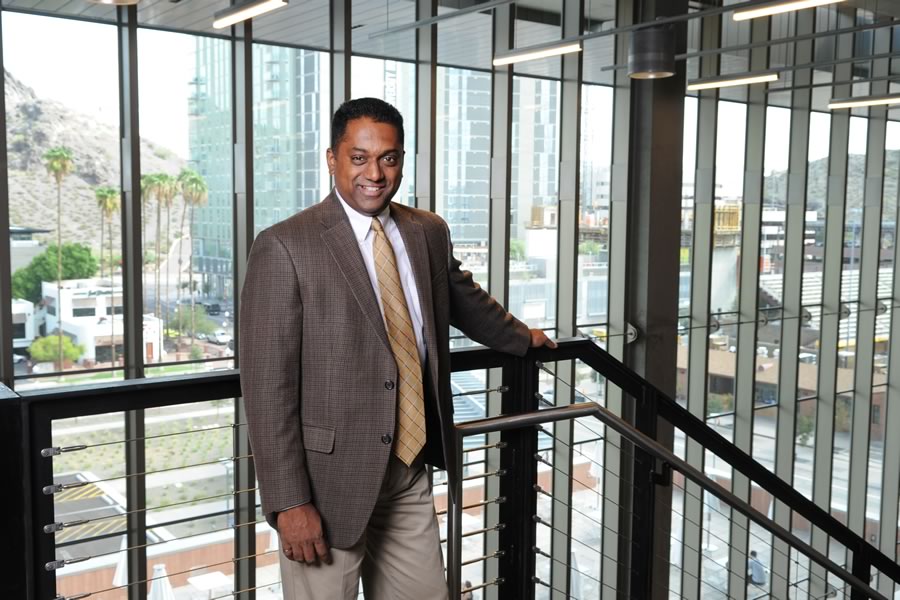
Sam Ariaratnam: Digging his way to the future
“ASU is a dynamic place. In real estate, it’s location, location, location. It’s the same in education. The Phoenix metro area has a dynamic construction industry and it is helping us build a world-class program.”Sam Ariaratnam is digging his way to the future. But...
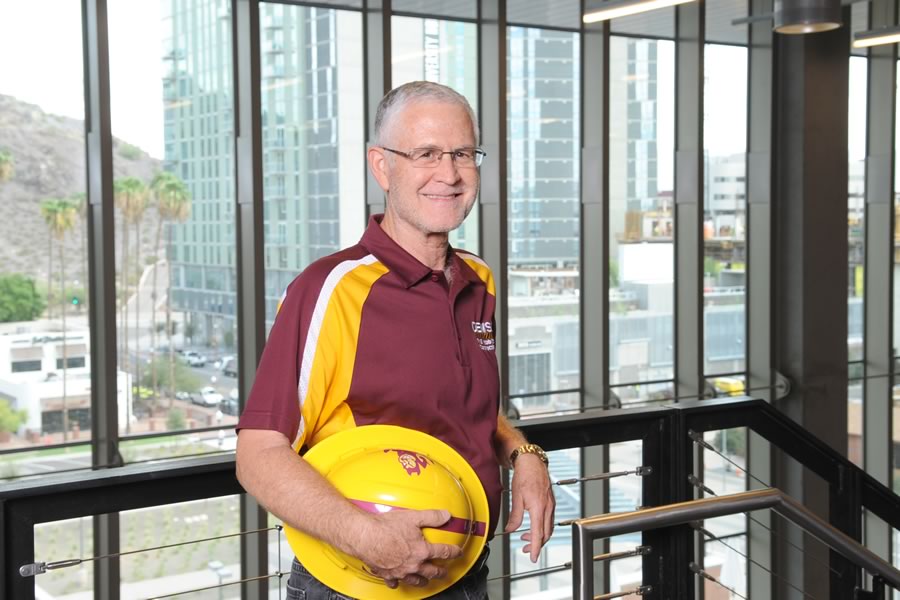
Allan Chasey: Embracing his construction destiny
“I enjoy seeing buildings going up. There are few professions where you can go back 20 to 30 years later and say, ‘I had something to do with that.'”Editor’s note: Allan Chasey retired in the fall of 2016, but his construction management legacy lives on in the DEWSC....
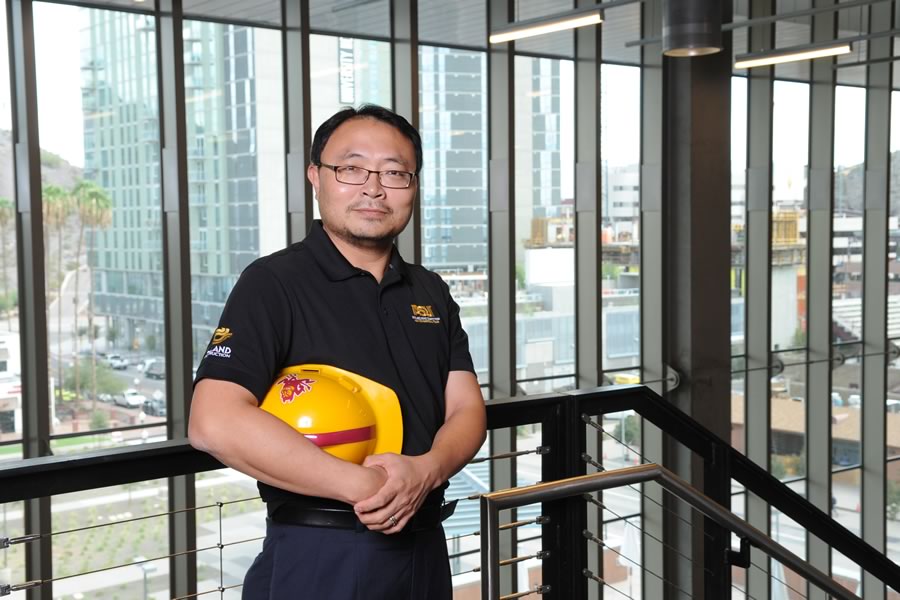
Oswald Chong: Seeking truth through data
Oswald Chong labels himself a skeptic. “I always question people indirectly as I don’t like to confront people directly,” said Chong, an associate professor in the Del E. Webb School of Construction, part of the School of Sustainable Engineering and the Built...

Mounir El Asmar: Looking to fuse disciplines
Mounir El Asmar has always been interested in multidisciplinary integration. Growing up in Beirut, Lebanon, and having gone through the French education system throughout his childhood, he juggled the idea of American versus French college education, and the majors of...
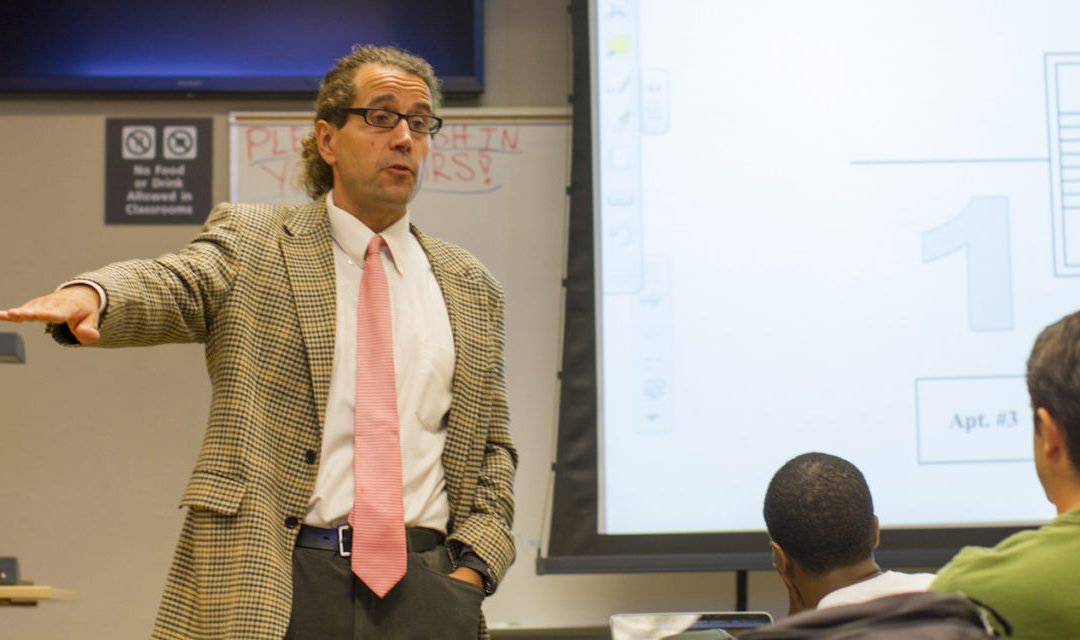
David Grau: The human element and variability
David Grau worked for years in the design and construction industry, and saw firsthand that the large complexity intrinsic to the delivery of capital projects resulted in variability and uncertainty. In turn, he observed that such uncertainty negatively impacts the...
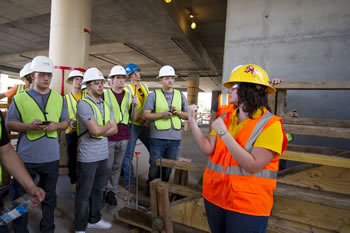
Kristen Parrish: A love affair with physics and teaching
Kristen Parrish – Sustainability Profile from ASU Engineering on Vimeo Kristen Parrish fell in love with physics in her 10th grade class in Michigan. “It was kinematic equations, figuring out how far you could drive a car up a ramp,” Parrish said. “I asked my...
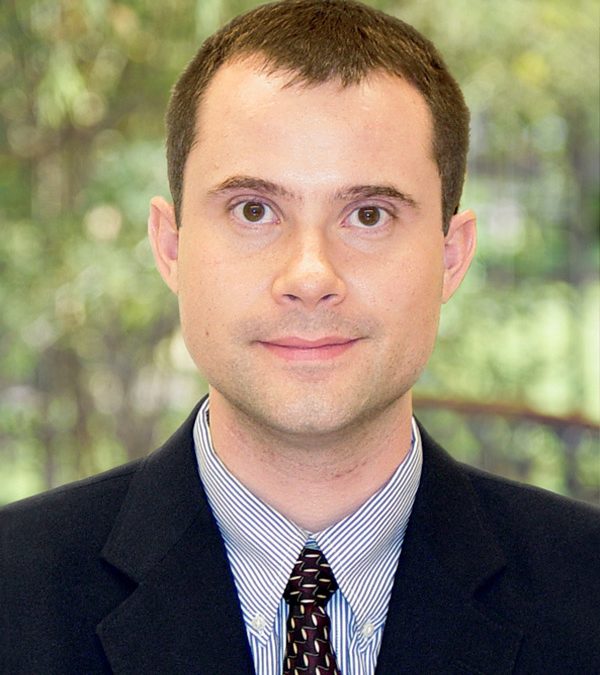
Kenneth Sullivan: ‘It’s all about people’
Kenneth Sullivan will tell you: Project performance? It is all about people. It always has been. “An efficiently engineered process can drive performance outcomes, but to truly optimize, the capability of the key individuals participating in that process is key. When...